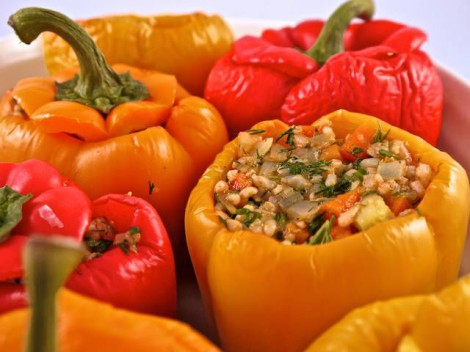Stuffed vegetables are very common in various cuisines of the world. They appear in different shapes and forms, depending on what is available in different geographical locations. There is a tremendous amount of recipe for stuffed vegetables and all seem to use one basic principle: you can stuff any vegetable that is solid enough to hold the filling, which can be a mixture of almost anything at hand in your kitchen. Afterwards, bake or potentially fry the dish. That’s quite flexible, isn’t it?
It is very common to use peppers, tomatoes, aubergines and courgettes to stuff, which can be filled with rice, minced meat or even grains. The filling tends to be mixed with onion, garlic, herbs and spices but nuts, pulses and raisins can also be added for a change of flavours.
In Spain, stuffed peppers – called “Pimientos Rellenos” – constitute a traditional dish, especially in the Basque Country. They use “Manchego” cheese, beef and cod in béchamel sauce. In India, “Bharvan Mirch” or “Bharva Hari Mirch” is a type of stuffed pepper that is filled with cooked meat, potatoes and onions. For seasoning, turmeric, cumin, chilli, coriander, salt and lemon juice are used. “Mirchi Bajji” is a type of stuffed pepper that is fried and served with sauces and chutneys. In Mexico, the fried “Chile Relleno” consists of cheese and minced meat and served with various sauces. Sometime rice and taco are served together with this stuffed pepper dish. Also, Mexicans use jalapenos to stuff in their “Jalapeno Poppers” that is also fried. In Guatemala, a similar, fried stuffed vegetable dish called “Pimiento” is common, which is filled with shredded pork and seasonal vegetables. And these are just a few examples!
The dish – in various forms – is also part of the traditional cuisines of Central and Eastern Europe, Southern Europe and the Mediterranean, the Balkans, Scandinavia, the Baltics, Central Asia, the Middle East and North Africa.
In my opinion, one of the most delicious and easy to make stuffed pepper dishes is from Greece. It’s called “Gemista” (or “Yemista”), which simply means “to stuff” in Greek. Baked peppers or tomatoes are stuffed with rice, minced meat and summer vegetables. Most Greek “tavernas” would use seasonal vegetables that they source from the local markets. It is easy to omit meat from the dish and create a wholesome but light vegetarian version of the “Gemista”. They are not only very delicious, but they please the eyes as the pretty and colourful peppers are lined up next to each other, baked to perfection.
I found the below vegan recipe on the website of Forks over Knives. The recipe was designed by Veronica Grace, a vegan chef, who is specialised on low fat vegan recipes. I made a few slight changes to the original recipe to suit my personal taste, but the changes are minor. The dish serves 3 to 4 people.
Ingredients:
- 6 large or 8 small bell peppers (of varying colours)
- 1 large onion (finely diced)
- 3 small courgettes (peeled and finely diced)
- 3 medium carrots (peeled and finely diced)
- 250 ml low-sodium vegetable broth (preferably home-made or if packaged, use organic)
- 500 gram brown rice (cooked to packet instructions)
- 5 tablespoons of tomato paste
- 20 grams of fresh parsley (finely chopped; if not available use 10 grams of dried parsley)
- 20 grams of fresh dill (chopped, if not available use 10 grams of dried dill)
- Juice of 1 lemon
- Pepper (according to taste)
- Salt (according to taste)
Preparation method:
- Preheat oven to 180 Celsius.
- Cut off the top of the peppers and deseed them. Retain the top with stem. Wash the peppers and tops thoroughly.
- Place the peppers in an ovenproof dish, arrange them upright and put tops back on. Bake them at 180 Celsius for 30 minutes.
- While the peppers are baking, sauté onions, courgettes and carrots in a vegetable broth for 5 minutes.
- Cook rice according to package instructions in a separate pot.
- Once the rice is ready, stir it into the onion, courgettes and carrot mixture. Add the tomato paste and mix well so that the tomato paste coats the vegetables.
- Add parsley, dill, lemon juice, pepper and salt and stir well to combine them thoroughly. The filling is ready.
- By now the peppers should be baked. Remove them from the oven and stuff the peppers with the filling.
- Place the pepper tops on the peppers and bake them for 30 minutes at 180 Celsius. (If the peppers start to brown, lower the temperature in the oven and keep an eye on them. They may require that you remove them from the oven earlier.)
This dish is very healthy and very nutritious. If you crave for strong Greek flavours, add a dash of cinnamon and oregano to the filling. I normally serve them with steamed or stir-fried French beans, okra or broccoli. Alternatively, fresh garden salad or baby spinach leaves are suitable side dishes too.
Bon appetite!


